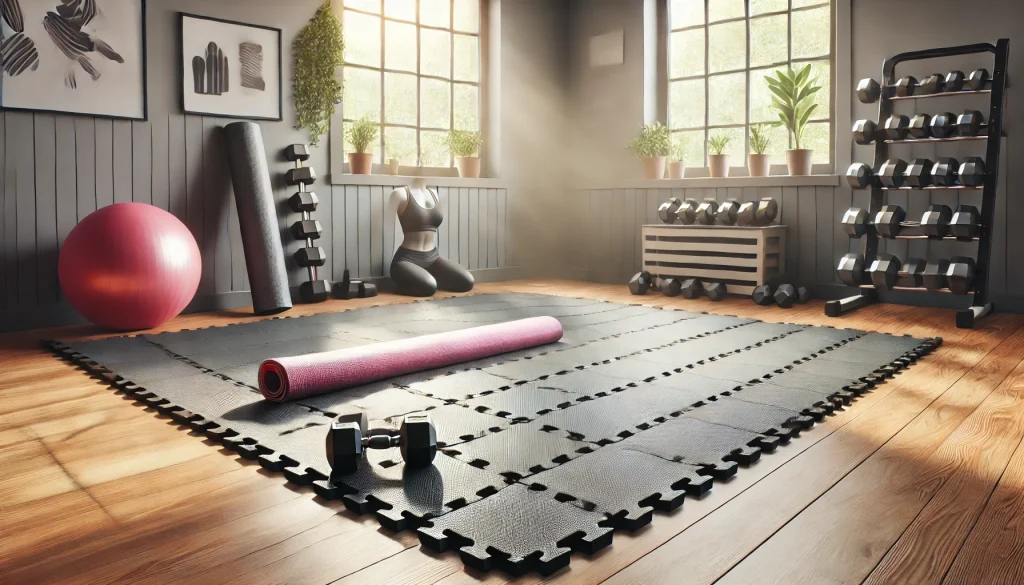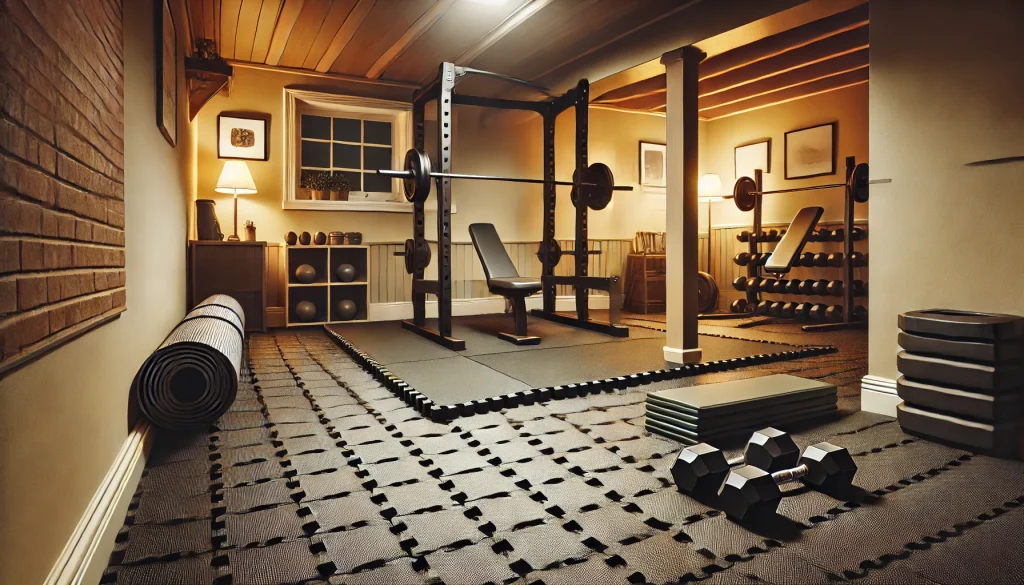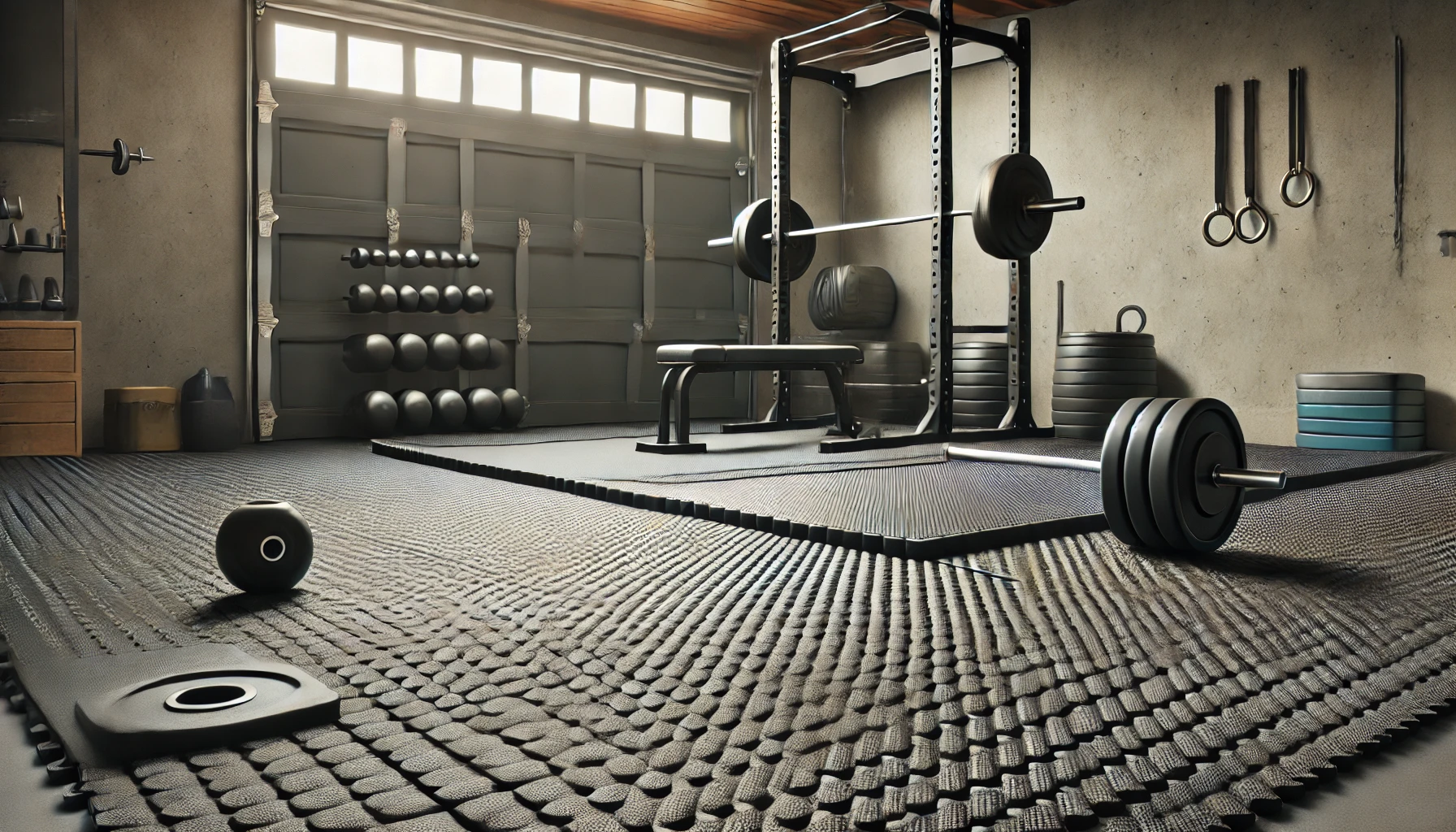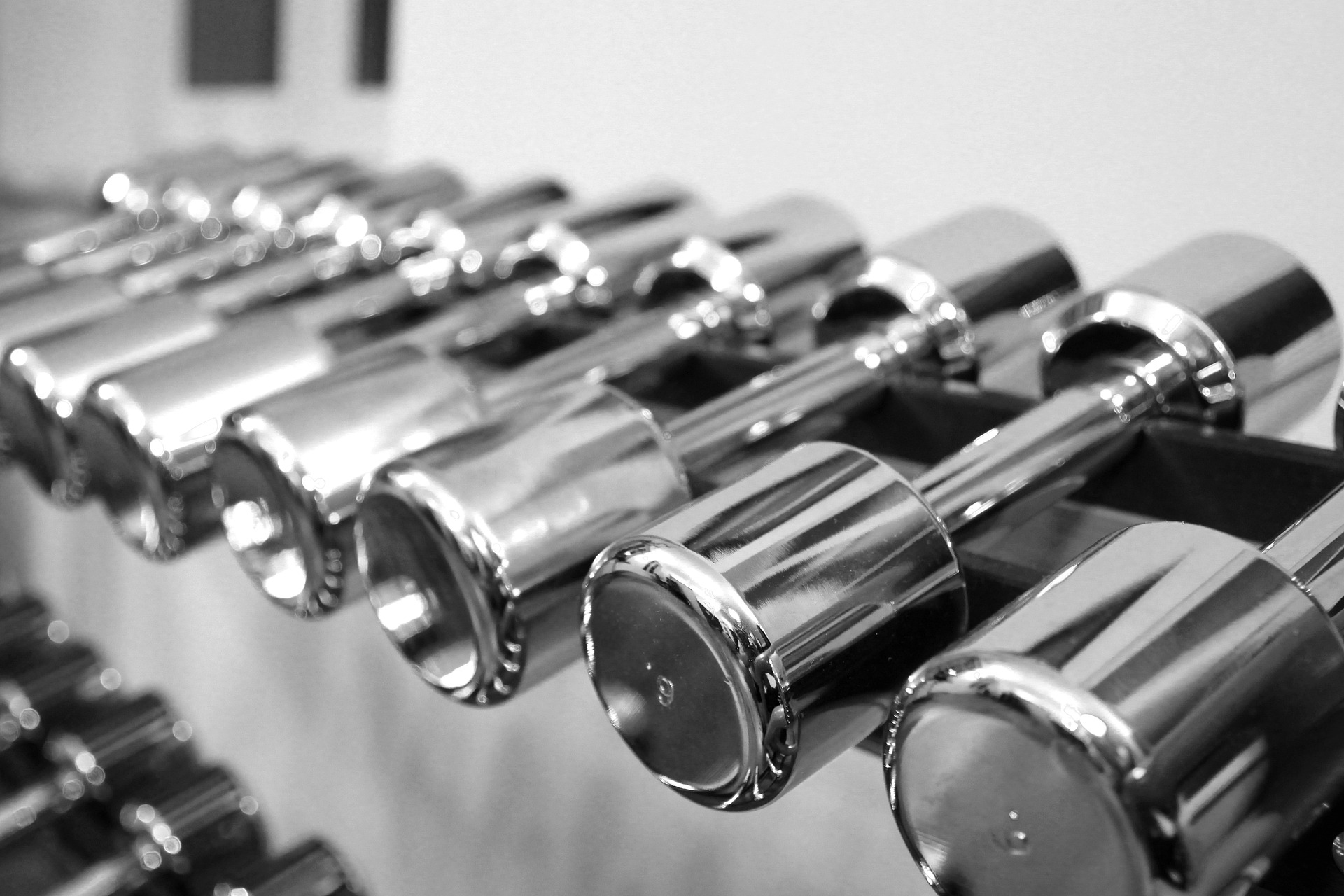Setting up a home gym requires careful consideration, especially when it comes to choosing the right gym flooring. Whether you’re lifting heavy weights, performing high-intensity cardio, or doing yoga, the type of flooring you select can significantly impact your workout experience. The right gym floor mat or gym flooring can protect your floors, reduce noise, and provide the necessary traction for a safe and effective workout.
In this guide, we’ll explore different types of gym flooring, from rubber gym floor mats to interlocking tiles and foam options. We’ll also highlight important factors like durability, ease of installation, and cost to help you find the perfect solution for your fitness space. Whether you’re setting up a garage gym or creating a dedicated exercise room, this article covers everything you need to know.
Why Is Gym Flooring Important?
Gym flooring is often overlooked, but it’s one of the most critical components of a home gym setup. Here’s why it matters:
- Protection for Your Home: A gym floor mat acts as a buffer between your heavy weights and the floor, protecting surfaces from damage. This is especially important for spaces like basements or garages where dropping weights can cause cracks or dents.
- Safety and Stability: Proper gym flooring provides a stable surface, reducing the risk of slipping during exercises. Rubber gym floor mats and workout rubber mats are known for their non-slip properties.
- Noise Reduction: High-quality gym flooring can help absorb sound, making it ideal for garage gym mats or basement workout room flooring. This way, you can work out without disturbing others in your home.
Types of Gym Flooring and Gym Floor Mats
Choosing the right type of gym flooring depends on your specific needs, workout style, and budget. Here are the most popular options:
1. Rubber Gym Floor Mats
Rubber gym floor mats are the go-to choice for many fitness enthusiasts. They are durable, versatile, and provide excellent shock absorption, making them perfect for weight lifting and high-impact exercises.
- Best For: Home gyms focused on weightlifting and heavy-duty workouts.
- Pros: Durable, easy to clean, non-slip surface, and great for absorbing shock from dropped weights.
- Cons: Can be more expensive than foam options and may have a rubber smell initially.
- Examples: Rolled rubber mats and interlocking rubber floor tiles.
2. Interlocking Rubber Floor Tiles for Home Gym
Interlocking rubber tiles are easy to install and provide a secure, seamless surface for your workout space. These tiles fit together like a puzzle, making them ideal for DIY gym flooring projects.
- Best For: Home gyms where flexibility in layout is needed, such as garage gyms.
- Pros: Easy to install, customizable, and provides excellent cushioning.
- Cons: Tiles may shift slightly over time, requiring occasional adjustment.
- Popular Brands: XSpec Interlocking Gym Tiles, AmazonBasics Rubber Tiles.
3. Foam Exercise Floor Mats
Foam exercise floor mats are a budget-friendly option for lighter workouts like yoga or stretching. They are softer and more comfortable underfoot, making them suitable for low-impact activities.
- Best For: Cardio rooms, yoga spaces, or areas where comfort is a priority.
- Pros: Affordable, easy to install, lightweight, and comfortable for floor exercises.
- Cons: Less durable than rubber mats, not suitable for heavy weightlifting.
- Ideal Use: Exercise floor mattress, gymnastics floor for home setups.
4. Stalemat-Style Mats for Weight Lifting
Stall mats, typically used for livestock, have become a popular choice for gym flooring due to their durability and cost-effectiveness. These heavy-duty rubber mats can withstand the impact of heavy weights.
- Best For: Garage gyms and basement workout rooms where heavy lifting is a focus.
- Pros: Extremely durable, cost-effective, and provides solid traction.
- Cons: Heavy and difficult to move, may have a strong rubber smell initially.
- Example: Tractor Supply Rubber Stall Mats.

Choosing the Best Floor Mat for Your Gym Space
Selecting the right gym flooring involves considering your workout style, the space you have, and your budget. Here’s a breakdown of key factors:
1. Durability
- Weight Lifting Mats: If your workout routine involves heavy weightlifting, opt for durable rubber mats or weight room mats that can handle the impact of dropped weights.
- Foam Mats for Light Exercises: For lighter exercises like yoga or Pilates, foam exercise floor mats offer sufficient cushioning without the need for high-impact resistance.
2. Space and Layout
- Garage Gym Flooring: For garage gym setups, rolled rubber mats or interlocking tiles are popular choices. They can cover large areas and provide the durability needed for a multi-purpose space.
- Basement Workout Room Flooring: In basements, moisture can be a concern. Rubber floor tiles for home gym use are resistant to moisture, making them a smart choice for basement workout rooms.
3. Ease of Installation
- Interlocking Tiles: These are easy to install without any special tools, making them a great choice for DIY enthusiasts. Here is a video tutorial explaining how to install them.
- Rolled Rubber Mats: While durable, rolled mats require more effort during installation, as they need to be cut to size and often require adhesive or double-sided tape for a secure fit.
4. Cost Considerations
- Budget-Friendly Options: Foam tiles and basic rubber mats are great for those looking to keep costs low while setting up a functional home gym.
- Premium Flooring Solutions: High-end options like thicker rolled rubber or premium interlocking gym tiles offer better durability and aesthetics but come with a higher price tag. It’s important to compare gym floor mat options to find the best value for your investment.
Top Gym Flooring Products for Home Gyms
Finding the best gym flooring or gym floor mat depends on your specific needs. Here are some of the top recommendations:
1. ProSourceFit Gym Flooring Mat
ProSourceFit Gym Flooring Mats are designed for versatility and comfort, offering a durable surface for a wide range of exercises. These interlocking foam tiles are ideal for creating a soft, cushioned space that is perfect for floor exercises, stretching, and light weightlifting. Their textured surface provides grip, ensuring stability during workouts.
- Features: Interlocking design, water-resistant, non-slip surface, and easy to assemble.
- Best For: Home gyms focused on stretching, bodyweight exercises, or creating a comfortable workout area in a garage or basement.
- Price Range: $ – $$
These mats are a great choice for those looking to set up a functional and comfortable home gym without a significant investment.
2. Rogue Fitness Rubber Gym Mats
Rogue’s rubber gym mats are a popular choice for serious lifters. Made from high-quality rubber, they provide excellent traction and shock absorption.
- Features: Available in various thicknesses, slip-resistant surface, and durable.
- Best For: Weight rooms and garage gym setups.
- Price Range: $$ – $$$
3. BalanceFrom Puzzle Exercise Floor Mat
This interlocking foam mat system is perfect for creating a soft and comfortable workout space. It’s easy to assemble and provides a cushioned surface for floor exercises.
- Features: Lightweight, water-resistant, and easy to clean.
- Best For: Yoga spaces, stretching areas, and light workouts.
- Price Range: $
4. AmazonBasics Rubber Interlocking Tiles
Amazon’s interlocking rubber tiles are a versatile solution for those who want a sturdy workout surface without the hassle of rolled rubber mats. They are ideal for creating a custom-sized workout area.
- Features: Durable, easy to interlock, and customizable.
- Best For: Garage gyms and basement workout room flooring.
- Price Range: $$
Maintaining Your Gym Flooring
Proper maintenance can extend the lifespan of your gym flooring and keep your workout area looking great. Here are some tips:
1. Cleaning Rubber Mats
- Use a mild detergent mixed with water to clean rubber gym floor mats. Avoid using harsh chemicals that could damage the surface.
- Regularly sweep and mop to remove dust and debris, especially in high-traffic areas like garage gym flooring.
2. Caring for Foam Exercise Mats
- Wipe down foam exercise mats with a damp cloth after each use to prevent the buildup of sweat and bacteria.
- Store foam mats in a dry area to prevent mold or mildew, particularly if they are used in a basement workout room.
3. Managing Seams and Shifts in Interlocking Tiles
- If your interlocking gym tiles shift over time, consider using double-sided tape underneath to keep them in place.
- Regularly check for gaps between tiles and adjust as needed to maintain a smooth, even surface.
Frequently Asked Questions About Gym Floor Mats
1. What Is the Best Gym Flooring for Weight Lifting?
For weight lifting, rubber gym mats or thick rubber tiles are the best options. They offer the durability and shock absorption needed to protect both your floors and your weights.
2. Can I Use Regular Carpet for My Exercise Room?
While carpet can be used in an exercise room, it doesn’t provide the same level of support and protection as rubber mats or gym tiles. Exercise room carpet can be comfortable for stretching or light workouts but isn’t ideal for heavy lifting.
3. How Much Do Rubber Floor Tiles for Home Gyms Cost?
The cost of rubber floor tiles can vary widely, ranging from $2 to $15 per square foot. For a more affordable option, consider interlocking tiles or basic rubber mats. High-end options, like thicker rolled rubber, tend to be more expensive but provide superior durability.

Conclusion
Choosing the right gym flooring or gym floor mat can transform your home workout space into a safe, comfortable, and effective exercise area. Whether you opt for durable rubber gym floor mats, budget-friendly foam exercise floor mats, or versatile interlocking tiles, it’s essential to match your flooring choice to your workout needs. For those building a garage gym or a basement workout room, investing in quality flooring ensures your space remains functional for years to come.
With the information provided in this guide, you’re well-equipped to select the perfect gym flooring solution. Start building your ideal home gym today with the flooring that suits your space, budget, and fitness goals.



